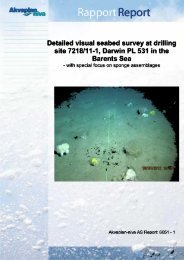A study of the priority substances of the Water Framework Directive ...
A study of the priority substances of the Water Framework Directive ...
A study of the priority substances of the Water Framework Directive ...
Create successful ePaper yourself
Turn your PDF publications into a flip-book with our unique Google optimized e-Paper software.
..:::::::::: simazine<br />
..:::70<br />
29 Simazine<br />
� Simazine has been used as herbicide to control<br />
grasses and broadleaves. It has also been<br />
used to clean aquariums, swimming pools etc.<br />
� The substance was banned in Norway in<br />
1995 and in EU in 2003.<br />
� The levels in Norwegian environment are relatively<br />
low, and <strong>the</strong> use is phased out.<br />
� Fur<strong>the</strong>r screening or monitoring is not regarded<br />
necessary.<br />
Production and use<br />
Simazine is used as herbicide against annual<br />
grasses and broad-leaved weeds in agriculture<br />
and forestry. The substance kills algae, and has<br />
been used in swimming pools, ponds, aquariums<br />
and cooling towers since <strong>the</strong> 1950ties. Simazine<br />
was removed from <strong>the</strong> Norwegian marked by<br />
<strong>the</strong> importer in 1995, as <strong>the</strong> product was<br />
restricted due to high persistence and high toxicity<br />
for algae. There are no entries in <strong>the</strong><br />
Norwegian Product Register since 1995.<br />
Simazine was banned in <strong>the</strong> EU from 2003.<br />
From 1979 to 1996 about 75 000 kilos <strong>of</strong><br />
simazine were sold in Norway, peaking in 1988<br />
with more than 7 000 kilos sold.<br />
Emissions, discharges,<br />
distribution and hot-spots<br />
The main source for emissions in Norway is<br />
agricultural use.<br />
Monitoring<br />
Simazine is monitored in JOVÅ.<br />
Fresh water<br />
Simazine in has been thoroughly monitored in<br />
several streams and rivers in Eastern and South<br />
Western Norway. Simazine was found in six<br />
rivers and streams and in approximately 10 %<br />
<strong>of</strong> <strong>the</strong> samples taken, but in low concentrations.<br />
Need for fur<strong>the</strong>r screening and monitoring<br />
Simazine is prohibited throughout Europe, and<br />
levels in <strong>the</strong> environment are low. No fur<strong>the</strong>r<br />
screening is regarded necessary.<br />
Analysis<br />
The analysis <strong>of</strong> simazine is <strong>of</strong>ten part <strong>of</strong> multi<br />
pesticide packages <strong>of</strong>fered by several laboratories.<br />
A <strong>study</strong> <strong>of</strong> <strong>the</strong> <strong>priority</strong> <strong>substances</strong> <strong>of</strong> <strong>the</strong> <strong>Water</strong> <strong>Framework</strong> <strong>Directive</strong><br />
TA-2140/2005<br />
FACTS<br />
Cas no.: 122-34-9<br />
Synonyms: Simazin, 2-chloro-4,6-bis(ethylamino)-1,3,5triazine<br />
gesatop 50 (50%), fisons simazin 50 (50%),<br />
radex framed 50 WP (50%), hora-mazine 50 (50%)<br />
Aquazine, Caliber, Cekusan, Cekusima, Framed,<br />
Gesatop, Primatol S, Princep, Simadex, Simanex, Sim-<br />
Trol, Tanzine and Totazine.<br />
Properties: White powder.<br />
Toxic effects: Simazine is not considered toxic for<br />
humans; for technical simazine oral LD50 in rats is ><br />
5000 mg/kg. However, simazine is toxic to sheep and<br />
cattle (500/mg/kg is fatal dose). Simazine is irritating<br />
to eyes in large doses. Simazine has low toxicity for<br />
fish, LC50 rainbow trout (Oncorhynchus mykiss) is ><br />
100 mg/l, but it is more toxic to invertebrates.<br />
Log Kow: 2,4<br />
Persistence: Half life for simazine is 22 hours in air, up<br />
to 149 days in soil and more than 30 days in water,<br />
but <strong>the</strong>se numbers depending on many factors.<br />
Plants that are sensitive to simazine accumulate <strong>the</strong><br />
substance. (EXTOXNET)<br />
DT50 in soil = median value is 49 days,<br />
DT50 in aerobic water = mean value <strong>of</strong> 61 days.<br />
(CIRCA)<br />
<strong>Water</strong> solubility: 5 - 6,2 mg/l<br />
Molecular formula: C 7 -H 12 -Cl-N 5<br />
Metabolites: N-Desethyl simazine and hydroxy<br />
simazine.<br />
Methods<br />
The methods are based on direct extraction with<br />
an organic solvent (sediment and biota) or solid<br />
phase extraction (SPE), eventually clean-up with<br />
SPE and separation and quantification with GCbased<br />
methods: GC/MS or GC/ECD, however,<br />
also LC/MS methods can be used.<br />
Synergy with o<strong>the</strong>r analyses<br />
Sample extraction and clean-up can be co-ordinated<br />
with <strong>the</strong> analysis <strong>of</strong> o<strong>the</strong>r pesticides which<br />
can be analysed by GC/MS especially o<strong>the</strong>r triazine-type<br />
herbicides as for example cyanacine<br />
or atrazine.

















